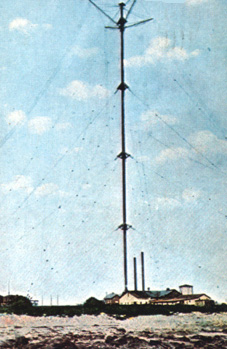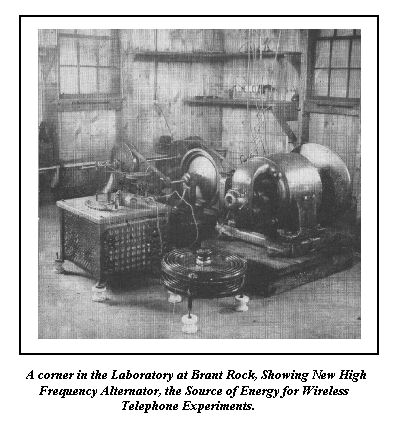|
Mainland High School
Suitable for a Disaster: ISTF 08-1835 |
|||||||||||||||||||||||||||||||||||||||||||||||||||||||||
|
Home
Introduction Contest Components One Two  Product Product
Three Fabrics History of Fabrics Smart Fabric Projects Sensors Nano Sensors Power Production Communication Cell Phones 3G Phones Data Transfer Helikites Interoperability Microwaves Relief Agencies Telecommunication Project Assessment Team |
History of Broadcasting and Telecommunications
Telecommunicating means
any transmission, emission, or reception of signals, writing, images, or other information
by wire, radio, or any other electromagnetic system. Being able to send messages
remotely has been the subject of many technological advances since the easliest
days of the concept.
The telephone was first invented in the 1870s by Alexander Graham Bell and Elisha Gray. They both came up with the idea around the same time and practically raced eachother to the patent office. Later they both entered a long legal battle over the patent and Alexander Graham Bell won. The birthday of the telephone was March 10, 1876, which was also the death of the multiple telegraph. Bell was able to develop the telephone using information about the earlier invention of the telegraph. By October 1874, he was able to inform his father-on-law of a multiple telegraph. Guglielmo Marconi's earliest radio transmissions, or Hertzian waves, carried dots and dashes in the forms of wireless telegraphy. Reginald Fessenden, a Canadian living in Brant Rock, Massachusetts, created a system, with the support of the National Electric Signaling Company, that had enough power to carry distinguishable audio sounds. His first broadcasts on December 24, 1906, were primarily to shipboard operators of the US Navy and United Fruit Company equipped with the Fessenden apparatus along the Atlantic Coast. The transmissions included sounds of his violin and bible passages. His financial supporters discontinued the project because they thought that it would have little practical use since it was only a one way signal to multiple receivers.
Google - Definitions of telecommunications http://www.google.com/search?hl=en&defl=en&q=define:telecommunication&ei=ChCaSdyyDdLjtgfG6YiZCw&sa=X&oi=glossary_definition&ct=title About.com - The History of the Telephone - Alexander Graham Bell http://inventors.about.com/od/bstartinventors/a/telephone.htm Nobelprize.org - Giglielmo Marconi http://nobelprize.org/nobel_prizes/physics/laureates/1909/marconi-bio.html GMFE 2009 - Giglielmo Marconi http://www.consorziofia.it/gmfe/gb/marconi.html About.com - Reginald Fessenden (1866-1931) http://inventors.about.com/library/inventors/blfessenden.htm Wireless Telephony and the High-Frequency Alternator http://earlyradiohistory.us/1940fes2.htm Inventing the Wireless Telephone and the Future http://ewh.ieee.org/reg/7/millennium/radio/radio_wireless.html Experiments and Results in Wireless Telephony http://earlyradiohistory.us/1907fes.htm#adapted Broadcasting's Forgotten Father: The Charles Herrold Story http://www.antiqueradios.com/chrs/journal/herrold.html What Was the First U. S. Radio Station? http://jeff560.tripod.com/first.html NationMaster - Charles Herrold http://www.nationmaster.com/encyclopedia/Charles-Herrold The Canadian Journalism Project - Charles Herrold: Inventor of Radio Broadcasting http://jsource.ca/english_new/detail.php?id=98 New World Encyclopedia - Broadcasting http://www.newworldencyclopedia.org/entry/Broadcasting#United_States Radio Music Box Memo (1916/1920) http://earlyradiohistory.us/1916rmb.htm United States Early Radio History - Lee DeForest http://earlyradiohistory.us/sec011.htm MBC - Sarnoff, David http://www.museum.tv/archives/etv/S/htmlS/sarnoffdavi/sarnoffdavi.htm IEEE - Frank Conrad, 1874-1941 http://www.ieee.org/web/aboutus/history_center/biography/conrad.html Access my Library - Radio http://www.accessmylibrary.com/coms2/summary_0193-11332_ITM Parxy.com - History of Walkie Talkies http://www.parxy.com/history-walkie-talkies.html TheHistoryOf.net - The History of Cell Phones - A Vision Realized http://www.thehistoryof.net/history-of-cell-phones.html World Space Week Boulder! http://www.colorado.edu/StudentGroups/CUSEDS/Events/WSW/2007/WSW2007.htm Sputnik the fiftieth anniversity - sputnik and The Dawn of the Space Age http://history.nasa.gov/sputnik/ The History of the Internet http://www.davesite.com/webstation/net-history.shtml A Brief History of the Internet URLhttp://www.walthowe.com/navnet/history.html Email History http://www.livinginternet.com/e/ei.htm About.com - Inventors Modems http://inventors.about.com/library/inventors/blmodem.htm |


